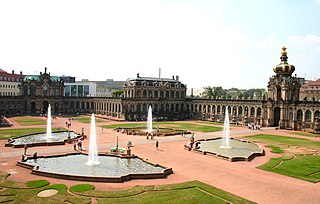
The Zwinger is a palatial complex with gardens in Dresden, Germany. Designed by architect Matthäus Daniel Pöppelmann, it is one of the most important buildings of the Baroque period in Germany. Along with the Frauenkirche, the Zwinger is the most famous architectural monument of Dresden.

Castle Howard is a stately home in North Yorkshire, England, within the civil parish of Henderskelfe, located 15 miles (24 km) north of York. It is a private residence and has been the home of the Carlisle branch of the Howard family for more than 300 years. Castle Howard is not a fortified structure, but the term "castle" is sometimes used in the name of an English country house that was built on the site of a former castle.

Lyme Park is a large estate south of Disley, Cheshire, England, managed by the National Trust and consisting of a mansion house surrounded by formal gardens and a deer park in the Peak District National Park. The house is the largest in Cheshire, and is recorded in the National Heritage List for England as a designated Grade I listed building.

Stowell Park Estate is a 6,000-acre (24 km2) historic agricultural and sporting estate in the Cotswold Hills, Gloucestershire, England. The estate includes the village of Yanworth. The main house is a Grade II* listed building and surrounded by extensive parkland, a mill, and a church. The landscaped park is listed as Grade II on the Register of Historic Parks and GardensNow owned by good old king charlie.

The Großer Garten is a Baroque style park in central Dresden. It is rectangular in shape and covers about 1.8 km2. Originally established in 1676 on the orders of John George III, Elector of Saxony, it has been a public garden since 1814. Pathways and avenues are arranged symmetrically throughout the park. The Sommerpalais, a small Lustschloss is at the center of the park.

Coade stone or Lithodipyra or Lithodipra is stoneware that was often described as an artificial stone in the late 18th and early 19th centuries. It was used for moulding neoclassical statues, architectural decorations and garden ornaments of the highest quality that remain virtually weatherproof today.

The Saxon Garden is a 15.5–hectare public garden in central (Śródmieście) Warsaw, Poland, facing Piłsudski Square. It is the oldest public park in the city. Founded in the late 17th century, it was opened to the public in 1727 as one of the first publicly accessible parks in the world.

The Saxon Axis is a feature of the historical city centre of Warsaw. It is a line running from the Vistula through the Presidential Palace, the Krakowskie Przedmieście, Saxon Square, Saxon Palace, Saxon Garden, Lubomirski Palace to Plac Żelaznej Bramy.

Kozłówka Palace is a large rococo and neoclassical palace complex of the Zamoyski family in Kozłówka, Lubartów County, Lublin Voivodeship in eastern Poland.
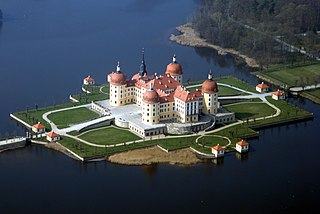
Moritzburg Castle or Moritzburg Palace is a Baroque palace in Moritzburg, in the German state of Saxony, about 13 kilometres (8.1 mi) northwest of the Saxon capital, Dresden. The castle has four round towers and lies on a symmetrical artificial island. It is named after Duke Moritz of Saxony, who had a hunting lodge built there between 1542 and 1546. The surrounding woodlands and lakes were a favourite hunting area of the electors and kings of Saxony.
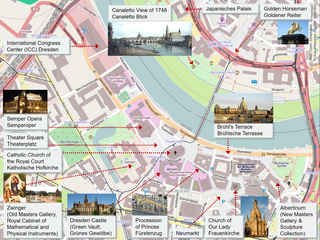
Dresden is a cultural centre in Germany which has influenced the development of European culture. "It is [...] outstanding as a cultural landscape, an ensemble that integrates the celebrated Baroque setting and suburban garden city into an artistic whole within the river valley, and as an example of land use, representing an exceptional development of a major Central-European city."

Schilling & Graebner was an architecture firm based in Dresden, Germany, founded by the architects Rudolf Schilling (1859–1933) and Julius Graebner (1858–1917) in 1889. The firm was under their direction from 1889 until Graebner's death, but continued to exist until 1947, most notably under Graebner's son Erwin (1895–1945). The firm, which initially devoted itself primarily to historicism and later to Art Nouveau and early modernism, worked on mainly buildings in Saxony, including several noteworthy churches, Dresden villas, administrative buildings and entire residential districts. One of the firms' most important works is the Christuskirche in Dresden (1903–1905), which arguably marks the transition of sacral architecture in Germany from historicism to modernity.

Dresden City Museum is the central city museum for the German city of Dresden. Its displays tell the 800-year story of the city and is the largest and most important of the Dresden State Museums. Its art collections split off in 2000 to form the Dresden City Art Gallery, but both the Art Gallery and the Museum are housed in Dresden's Landhaus.
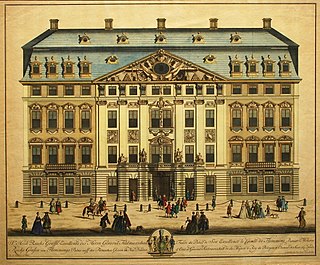
The Palais Flemming-Sulkowski was a Baroque city mansion in Dresden, Germany. It stood on the Inneren Pirnaischen Gasse, on the site now occupied by the city's Landhaus.

The Dresden City Art Gallery is the municipal art collection of Dresden, Germany, housed in the city's Landhaus. It was formed by the 19th and 20th century artworks of the Stadtmuseum Dresden, split off from the Museum and given a separate display in 2000. In 2002, Gisbert Porstmann became the founding director of the Dresden City Art Gallery, which officially opened in 2005.

Pillnitz Palace is a restored Baroque schloss at the eastern end of the city of Dresden in the German state of Saxony. It is located on the right bank of the River Elbe in the former village of Pillnitz. It was the summer residence of many electors and kings of Saxony; it is also known for the Declaration of Pillnitz in 1791.

The Sächsisches Ständehaus is a building in Dresden, Saxony. It was built to house the Landtag of the Free State of Saxony.
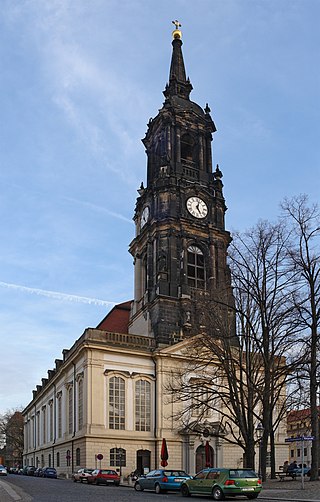
The Dreikönigskirche is a Lutheran church located in the Innere Neustadt of Dresden, Germany. It is the centre of a parish, and a community venue called Haus der Kirche. The church is a listed cultural monument of Dresden.

The Theaterplatz in Dresden is a historic square in the city. It is located in the west of the inner old town.
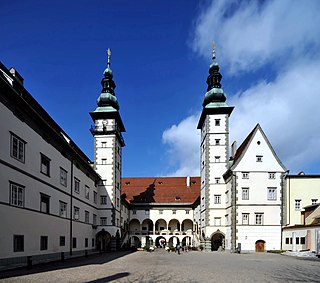
The Landhaus Klagenfurt located between Heiligengeistplatz and Alter Platz on the edge of the oldest part of downtown Klagenfurt, Austria, is a historically significant secular building in the Carinthian capital of Klagenfurt. It was built between 1574 and 1594 as part of the city's expansion and fortification efforts, commissioned by the Carinthian Landstand. Today, the Landhaus remains a symbol of Carinthian history and tradition and serves as the seat of the Carinthian state parliament.






















